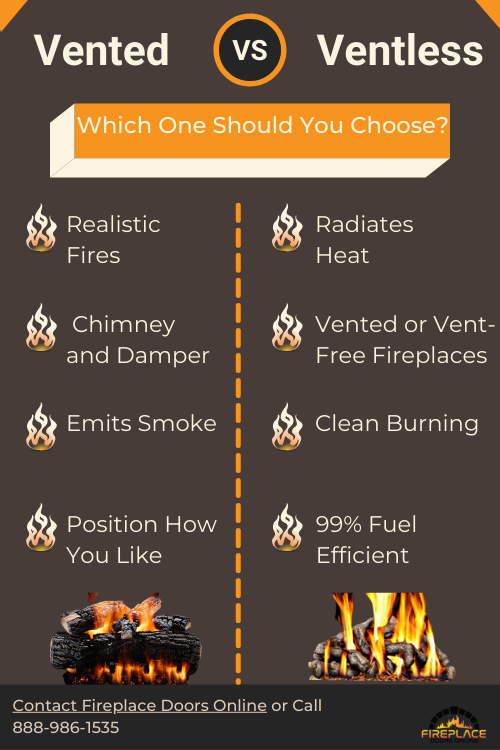The Difference Between Vented and Ventless Gas Logs
The Difference Between Vented and Ventless Gas Logs
Shopping for new gas fireplace logs can be a confusing and exhausting experience. By now, you’ve likely discovered that you need one of two types of gas logs for a fireplace – vented or ventless.
Well that’s a starting point, but what’s the difference between vented and ventless gas logs, and does it matter which one you choose?
To be honest, yes there’s quite a big difference between vented and ventless gas logs for a fireplace, and which one you choose matters more than most first-time gas fireplace owners typically realize. If you’re looking for fireplace gas logs but aren’t sure about the difference between vented and ventless gas log sets, we’re here to help your decision-making process and get your gas fireplace or other gas-burning fire feature up and running right away.
A Quick Overview of Using Gas Logs for Indoor Fireplaces
Before we jump into the differences between vented and vent-free gas logs, it’s important to clear up a few general guidelines for using gas logs. Whether or not you choose vent-free or vented gas logs for your home depends on the type of gas fireplace you have and its setup. Most all modern gas fireplace designs are for burning either vented or ventless gas logs, and in some cases both.
Here are a few general rules for homeowners to follow when choosing gas fireplace logs and shopping for gas log sets for your home:
-
Only use vented gas logs in a vented fireplace.
-
Only use ventless gas logs for your ventless fireplace.
-
You can use ventless gas logs in a vented gas fireplace with the damper closed.
-
You cannot use vented gas logs in a ventless or vent-free gas fireplace.
These rules not only ensure you’re properly using your fireplace gas logs but following these rules will help keep you and your loved ones safe while using your gas-burning features. If you’re new to owning a gas fireplace or haven’t had to shop for replacement logs for gas fireplaces before, then there are some important safety considerations you have to make.
Whenever you’re unsure about how to use your gas fireplace or not certain about the accessories you’ll need for your gas-burning features, please consult with a gas fireplace professional before making any final decisions or installations.
Benefits of Using Gas Fireplace Logs
We can go on all day about the benefits of using gas fireplace logs for your home. Although you’ll need to know how to measure for a new gas log set and choose between vented vs ventless gas logs, your new gas logs will offer more benefits than we can list.
Regardless of whether you ultimately go with vented or ventless gas logs, a few of the great benefits you can expect to enjoy from your new log set include:
-
Efficiency: ventless gas logs are an especially efficient option for your home as they burn 99 percent of the gas used in your gas fireplace.
-
Durability: with regular maintenance and proper use, both vented and ventless gas logs can easily last upwards of 10 plus years, and in some cases, gas logs can last a lifetime.
-
Affordability: after the initial investment, you don’t have to spend time and money finding or chopping firewood for your fireplace. Consider the durability of gas logs and how your investment is spread out over many years, and gas logs are an affordable option for your home.
-
Reliability: both vented and non-vented gas logs run on natural gas or liquid propane gas (LPG), so you can safely use them during power outages.
Starting vented and ventless gas logs in your fireplace can be as easy as flipping a switch or pressing a button on your remote control. Since you don’t have to take time to chop wood, find firewood for sale or get a wood-burning fire started, gas logs will also save valuable time. That’s time you could be spending sitting down, relaxing next to the fireplace.
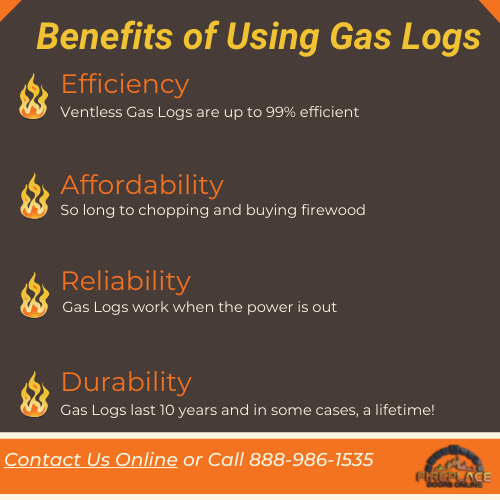
Vented vs Ventless (Vent-Free) Gas Logs
It may seem like gas logs are just another basic fireplace accessory, but choosing the right gas logs is a fairly important decision that involves several different factors. The biggest differences between vented and vent-free gas logs are how each type works in your fireplace and the types of fireplaces where you can use them.
Now, we realize that this is a pretty general simplification of the vented vs ventless gas logs debate. So to help clarify, let’s take a closer look at each type of gas log, the types of fireplaces where they’re used and then we’ll also take time to answer a few of the most common gas log questions to help you find the right gas log set for your home.
What are Vented Gas Logs?
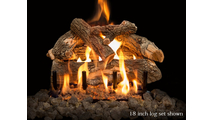 Vented gas logs are more than just fake fireplace logs meant to resemble real wood. Most vented gas fireplace logs are made from ceramic bonded refractory cement that allows them to withstand the high temperatures associated with burning your natural gas or propane fireplace.
Vented gas logs are more than just fake fireplace logs meant to resemble real wood. Most vented gas fireplace logs are made from ceramic bonded refractory cement that allows them to withstand the high temperatures associated with burning your natural gas or propane fireplace.
Vented gas logs burn very similarly to real firewood logs, so your fireplace looks as realistic as possible while burning fires. This type of gas log even emits smoke and other byproducts as a result of combustion.
That said, there are certain types of fireplaces designed to accommodate vented gas logs.
What Type of Fireplace Uses Vented Gas Logs?
Similar to burning real wood logs, vented gas logs also need a chimney with a damper installed before being burned in an indoor gas fireplace. Vented gas logs emit smoke and other byproducts such as soot as a result of the combustion process.
This is a big reason why burning vented gas logs closely resembles burning real wood logs. Their realistic characteristics are also why vented logs need to be used in a fireplace with a chimney and damper installed to allow any smoke and byproducts to escape.
The vented gas fireplace logs for sale on the market today are designed for either a gas-burning fireplace with a chimney and damper installed or a wood-burning fireplace that has been converted to burn natural gas or propane. Since a wood-burning fireplace already has a chimney and damper installed, it is easily converted to burn gas and uses vented gas logs.
What are Ventless Gas Logs?
If you have a gas-burning fireplace without a chimney, then you’ll need to go with ventless gas logs for your fireplace. Similar to vented gas logs, ventless gas fireplace logs are an alternative to burning real wood fireplace logs, but with a little more versatility than their vented counterparts.
Vent-free log sets are made from refractory cement that allows manufacturers to create designs closely resembling real wood logs. Since they don’t emit smoke and burn clean, vent-free gas logs do not need a damper or chimney. Ventless gas logs use 99 percent of the fuel burned for combustion, which significantly decreases soot and improves your gas fireplace’s fuel efficiency. Along with this, unvented gas logs also use less fuel while burning, allowing you ways to save money on gas bills.
It is important to note that ventless gas logs are capable of producing smells as well as depleting the oxygen levels in a room. This is why the ventless gas log sets for sale today come with oxygen (O2) sensors that detect when oxygen levels in the room are low or becoming depleted. Although some customers say they enjoy the smell of ventless gas logs, some people can be sensitive to the aroma of burning vent-free gas logs.
Ventless gas logs are very safe to use in your home, but as is the case with any gas-burning fireplace, you should always consult with a gas installation professional before installing and burning ventless fireplace logs in your home.
What Type of Fireplace Uses Ventless Gas Logs?
Ventless gas logs are used in heat-producing gas fireplaces and other gas-burning features. As we touched on, vent-free gas logs offer you a way to use a gas fireplace without needing a chimney and damper installed. This is great news for anyone living in an apartment or other community living environment.
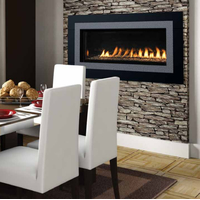 Vent-free fireplaces, which are essentially fireplaces without a chimney and damper system installed, are commonly found in apartment buildings and other community living environments.
Vent-free fireplaces, which are essentially fireplaces without a chimney and damper system installed, are commonly found in apartment buildings and other community living environments.
There are a lot of regulations surrounding where you can and can’t build a vent-free fireplace, so you’ll want to check with your local building codes before moving forward with plans for a ventless fireplace and purchasing the gas logs to match.
Using ventless gas logs in a vented fireplace impacts their ability to radiate heat, so you’ll want to close your damper to keep as much heat from escaping as possible.
Unlike vented gas logs, you’ll have to make a few considerations before choosing ventless gas logs for your fireplace.
What To Consider Before Choosing Ventless Gas Logs for Your Fireplace?
Choosing the right vent-free gas log set for your home is a little more involved than buying vented gas logs. There are additional things to consider before buying a ventless gas log set such as:
-
Measuring your room for ventless gas logs
-
Sensitivities to allergies, asthma or other breathing issues
-
State, local and municipal codes for ventless gas logs
As you can see, choosing the right ventless gas logs for your home is a little more complex than you might think. Let’s expand a little on each of these topics to give you all the information you need to get started with ventless gas logs in your home.
How To Measure a Room for Ventless Gas Logs?
One of the most important regulations involves measuring your room for the maximum amount of British Thermal Units (BTUs) that are legally allowed. This will also give you a solid idea of the gas log set you need to buy and how to choose the best gas log set for your home.
.png?1648740197082)
Using this formula, you can start to pair ventless gas log sets with the fireplace and the room where you’ll use them. It’s important to know that ventless gas fireplaces designed for ventless gas logs can’t be built in small rooms such as bathrooms, bedrooms and other small confined areas.
Ventless logs are not designed to heat your entire home, either. They are more of a supplemental heating option for the room or area in which they’re used.
How Ventless Gas Logs Impact Allergies, Asthma or Other Breathing Issues?
Since ventless gas logs can lower oxygen levels and produce other byproducts as a result of combustion, they’re not the best choice for people living with allergies, asthma or other breathing and respiratory problems. As we mentioned, ventless gas logs also tend to produce a smell, similar to kerosene, and also produce moisture as a result of burning.
Ventless logs can also release small amounts of Nitrogen Dioxide (NO2) into the air while burning because there is no chimney for the gas to escape up. Both moisture and the presence of NO2 can trigger anyone suffering from asthma or other breathing issues that might make them sensitive to substances in the air. Many times, you can open a window to let more air into the room, but this might mitigate some of the heating benefits and capabilities of your ventless gas logs.
State, City and Municipal Codes for Ventless Gas Logs
You’ll want to double-check with your state, city and local building code before moving forward with plans for building ventless features in your home. Certain states such as California have banned the use of ventless fireplaces and ventless gas logs altogether, so having this information ahead of time will save you lots of time and money.
Answering Vented vs Ventless Gas Log Questions
Inevitably, there are pros and cons associated with each type of gas log, so making an informed buying decision is the best way to get what you want for your home. We understand that gas logs can get pretty technical, so the pros at Fireplace Doors Online are always standing by ready to answer your questions.
Feel free to reach out online or give us a call at 888-986-1535 and a member of our team will be happy to answer your specific gas log questions. For now, we’ve taken the time to answer a few of the most commonly asked gas log questions that we get here at Fireplace Doors Online.
Which Produces a More Realistic Fire: Vented or Ventless Gas Logs?
Many homeowners want a realistic fireplace experience when burning their gas logs. One of the best parts of owning a fireplace is the cozy and inviting feel of a fire burning. If you want the most realistic fireplace experience possible, vented gas logs are your choice. Vented logs more closely resemble real burning wood than vent-free logs.
Vented gas logs can be thought of as ceramic logs for gas fireplaces as they are designed for the flames to touch, dance and curl all around them. You can also position vented gas logs in your fireplace however you see fit. Meaning you can stack your vented gas logs in a way that will further give off the appearance and characteristics of burning real wood logs in your fireplace.
Which Type of Gas Log is More Energy Efficient: Vented or Ventless?
Ventless gas logs are much more energy-efficient than vented logs. Ventless gas logs are one of the most energy-efficient options you have for your home. As we touched on earlier, ventless gas logs use 99% of the fuel burned and radiate heat back into the room where they’re used. The efficiency of ventless gas logs means you’ll use less fuel to operate your ventless gas fireplace, saving you money on heating and gas bills.
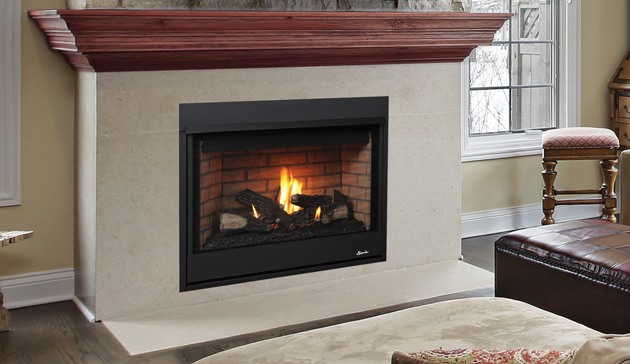
Which Type of Gas Log Gives Off More Heat: Vented or Ventless?
Even if you have ventless and vented gas log sets that burn at the same BTUs, you’ll lose more of the heat generated by vented gas logs as it escapes up and out the chimney. Since a lot of the heat generated by vented gas logs is lost up the chimney, ventless gas logs are better for heating your home. Again, the efficiency of ventless gas logs plays a big role in their ability to heat a room.
Finding the Right Set of Gas Logs for Your Home with Fireplace Doors Online
Gas fireplace logs are clearly more than just an optional decorative fireplace accessory. A quality vented or ventless gas log set is a solid investment for your home that offers several short and long-term benefits. Understanding the difference between vented fireplaces and vent-free fireplaces will help you determine which type of gas log set is right for you plus save you valuable time and money in the long run.
Vented gas logs must be used in a vented fireplace or in one that has a chimney with a damper. Likewise, ventless gas logs can be used in both types of gas fireplaces but there are more restrictions and considerations to account for when choosing to go with a ventless gas log set in your home.
If you need more help finding the best gas logs for your fireplace, then our team of qualified professionals is standing by, ready to help! Browse the Fireplace Doors Online store for a range of both vented and ventless gas log sets to get the most out of your gas fireplace.
Our beautiful gas log sets offer something for everyone. From ventless gas log sets designed to keep you cozy and warm to vented gas log sets that closely mimic real fires, we have the gas logs you need to make your fireplace experience the best it can be.
We also offer FREE shipping on all orders within the continental U.S.
You can also check out our gas log buying guide. Our gas log guide has everything you need to know before buying new or replacement logs for your gas fireplace. Check it out now -- available in the FDO store!
Have more questions about finding the best vented or ventless gas logs for your home? Feel free to contact us online or give us a call directly at 888-986-1535 to speak with one of our knowledgeable customer service staff.
No posts found


